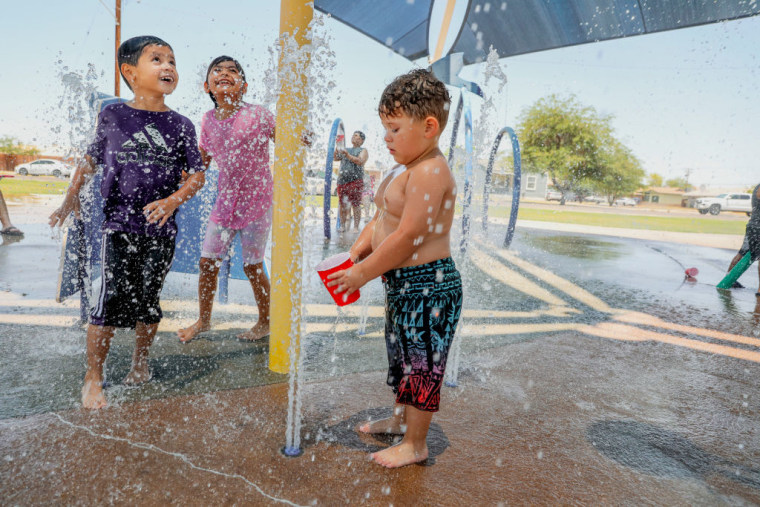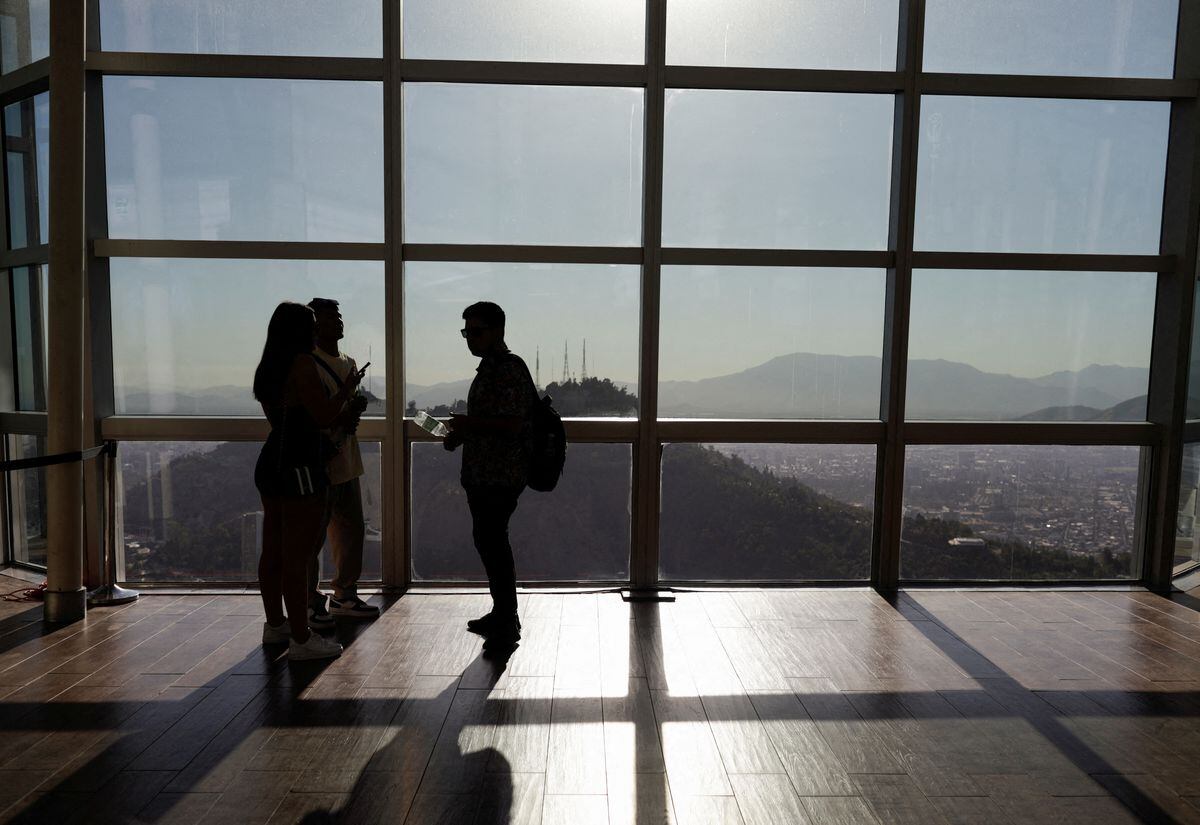By Denise Chow, Evan Bush and Alicia Victoria Lozano -
NBC News
The high temperatures and humidity that affected much of the United States last week have been coupled with the problems that many people suffer from inflation and high energy costs.
In Macon, Georgia, where temperatures were expected to be above 90 degrees over the weekend before hitting triple digits this week, Army Corps Administrator Sgt. Melissa White Salvación, said that its facilities have been full of people seeking relief from the heat.
[Recent graduates have “incredible” job opportunities. So they can get the right job]
"With the price of gas, people can't afford to run air conditioners, even if they have them," White explained.
"So it's forcing a lot of people who have never looked for help to go to these refrigeration stations," she added.
Nearly a third of the US population was under heat warnings and advisories last week due to an early-season heat wave that is engulfing much of the country, bringing scorching temperatures and high humidity to millions of Americans. throughout the Midwest and South.
"Either I buy food or I pay rent": Inflation pushes many Latinos to make difficult decisions
June 17, 202202:04
Scientists have claimed that climate change is causing more frequent and intense heat waves in the United States and around the world.
As temperatures rise, access to cooling resources can be a matter of life and death.
The Salvation Army of Macon is expanding its operations during the heat wave to serve as a cooling center for the public.
The organization also runs a shelter where people can stay overnight, and White said she and her colleagues are already struggling to keep up with demand, especially with forecasts projecting high heat and humidity to remain for weeks.
[The end of free school lunches in the US will create a “perfect storm” amid high inflation]
"We have such a large influx that we are studying the possibility of opening a second place in our worship center," he explained.
“Technically, we have a 122-bed system, but we also have cots and we keep taking people in until we can't get them in anymore,” he added.
Cities across the country are taking similar steps to protect residents from heat-related illnesses and deaths.
The local governments of Phoenix, Denver and Detroit announced plans last week to open cooling centers, distribute water and erect new structures to provide shade.
Heat is sometimes known as a “silent killer” because the symptoms of heat-related illnesses can often go unnoticed until it's too late.
The body's organs can become overworked and shut down if they lose their ability to regulate temperature, and heat can also aggravate symptoms of underlying conditions like heart disease, diabetes, or kidney problems.
Children play in a water park as the temperature reaches 115°F on June 12, 2022 in Imperial, Calif. Sandy Huffaker/Getty Images
Young children, the elderly, the homeless and individuals with pre-existing medical conditions are among those most at risk of heat-related illness and death when temperatures soar.
It's been so hot in the Columbus, Ohio area that the air conditioning can't keep up, says 59-year-old Yvette Moyler.
[Beauty Products Company Revlon Files For Bankruptcy Due To Heavy Debt And Competition From Social Media Celebrities]
"In this weather, it's hard to breathe," said Moyler, who lives in Worthington, a northern suburb of Columbus, where a heat advisory was in effect until Thursday.
Temperatures reached 90 degrees on Tuesday, with the heat index topping 110 degrees, according to the National Weather Service.
Moyler, who lives alone, is recovering at her home in Columbus after breast cancer treatment and continues to experience the side effects of radiation and other treatments.
Heat intensifies her symptoms.
The heat dries out your sinuses, damaged during treatment, and makes it hard for you to breathe.
It intensifies the hot flashes you experience while taking the medication.
And it leaves your bones aching.
"If it's too hot, it hurts," Moyler laments.
Power outages last week compounded heat problems in the Columbus area.
Moyler lost power overnight Tuesday, but considered herself lucky as nearby residents and businesses had suffered longer outages.
[The increase in the price of fuel forces some emergency services to reduce their benefits]
Last week, severe storms in Ohio downed power lines and damaged infrastructure.
Nearly a quarter of a million customers of the local utility, AEP Ohio, lost power Tuesday night, including many in the Columbus area, according to the company's website.
People walk through downtown as temperatures reach about 115 degrees on June 12, 2022 in Calexico, California. Sandy Huffaker/Getty Images
The blackout, combined with the heat, sent staff from Lifecare Alliance, a local nonprofit organization, scrambling to hand out ventilators, transport people to an air-conditioned center and provide meals to those in need.
Moyler received a fan from the agency, which distributes about 4,000 a year.
Chuck Gehring, president and CEO of LifeCare Alliance, which has about 30,000 clients in central Ohio, said the organization's volunteers called more than 1,500 clients Tuesday to check on their cooling and food needs.
He said many people were being squeezed by the cost of cooling, which this year has been made worse by inflation and high energy prices.
[Is there a risk that the economy will enter a recession soon? This is what you should know]
"We have a lot of people who either don't have air conditioning in an older house or can't afford to turn it on," Gehring said.
“A lot of them don't turn it on because they're afraid if they can't pay the bills they'll be evicted,” he added.
Inflation and rising energy prices have a disproportionate impact.
The US Department of Energy says that low-income families typically spend about 8.6% of their budget on energy, nearly triple what higher-income families pay.
The average residential electricity price is forecast to rise nearly 4% from last summer, according to the US Energy Information Administration's Summer Energy Outlook.
A 3-month-old baby dies in Pennsylvania inside her parents' truck in the middle of a heat wave
June 18, 202200:41
"It's hard for middle-class families -- they're being hit by higher gas prices, higher home energy prices and higher home heating costs next winter," said Mark Wolfe, CEO of the National Association of Directors of Energy Assistance.
"For low-income families, this is catastrophic," he added.
[Mortgage or car loan: this is how the biggest increase in interest rates in 28 years will affect your pocket]
In California, where temperatures can vary by 20 degrees or more between coastal cities and inland communities, heat waves have become a public health crisis compounded by income inequalities.
A 2021 study by the University of California, Davis found that low-income areas of the Southwest are on average 4 to 7 degrees warmer than wealthy neighborhoods in the same metropolitan regions.
The largest heat disparities were found in the Southern California cities of Riverside and San Bernardino, with Latino communities bearing the brunt of scorching temperatures.
According to the study, Latino neighborhoods are almost 7 degrees warmer than non-Latino areas.
This disproportionate impact can mean an increase in emergency calls and hospital visits during heat waves.
[American Airlines Raises Pilot Salary for Two Regional Airlines by 50% Due to Staffing Shortage]
“On any given day of extreme heat, Los Angeles emergency rooms see 1,500 more patients,” says Dr. David Eisenman, director of the Center for Public Health and Disasters at the University of California, Los Angeles.
"We estimate that in a single hot day, 16 more people die in Los Angeles County."
Black and Latino communities suffer the worst health consequences during extreme heat episodes, he added, with up to 18% excess deaths compared to white Los Angeles.
Inflation forces several people to spend less on travel, restaurants and the hairdresser
June 18, 202200:55
For example, neighborhoods in low-income areas, such as South Los Angeles, send 20 to 30 more people to the ER on hot days, compared to two more people in wealthier neighborhoods are just a few miles away, Eisenman said.
[Would you like to have a four day work week? So you can convince your company to put it into practice]
These inequalities are expected to widen as heat waves become more frequent and severe as a result of the climate emergency, putting additional pressure on cooling resources for public health and safety.
“Refrigeration is still perceived more as a luxury.
It's an outdated view from 30 or 40 years ago," Wolfe said.






/cloudfront-eu-central-1.images.arcpublishing.com/prisa/JUSJMP3AZFFMVFE7EXS567CYJE.jpg)



/cloudfront-eu-central-1.images.arcpublishing.com/prisa/KMEYMJKESBAZBE4MRBAM4TGHIQ.jpg)

